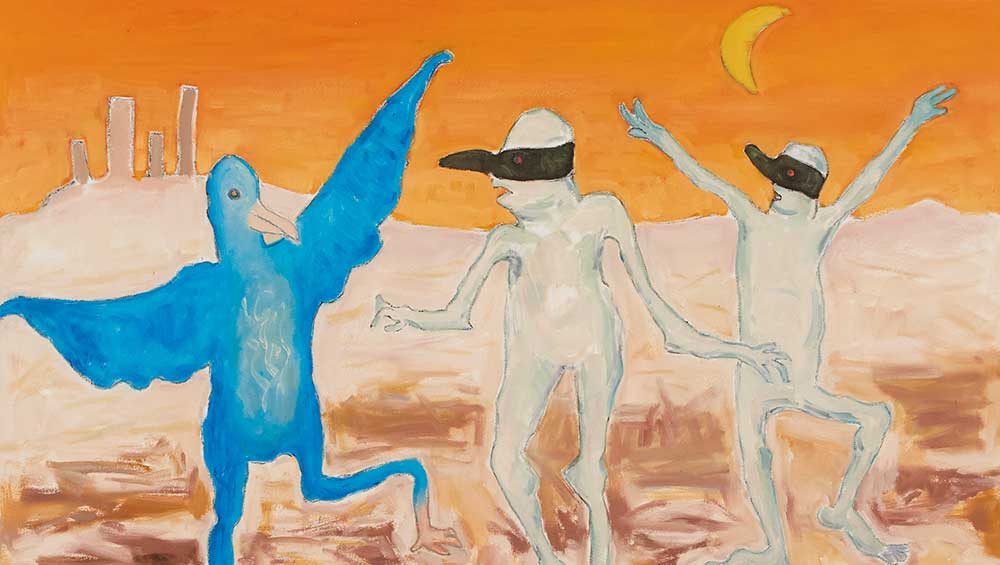
Erica Rutherford, To my Tune, 1995 (detail). Oil on canvas, framed: 113.7 x 139 cm. Copyright of the Estate of the Artist and Courtesy Richard Saltoun Gallery, London, Rome and New York.
Richard Saltoun Gallery, London
12 November – 21 December 2024
by BETH WILLIAMSON
The Scottish-Canadian artist Erica Rutherford (1923-2008) was one of the first openly transgender British artists. At 14, Rutherford left home to join Dartmouth Royal Naval College and spent a year as an apprentice cadet on HMS Conway in Liverpool. After leaving the navy in 1938, Rutherford enrolled at the Royal Academy of Dramatic Arts and spent time touring second word war army camps to perform for the troops. This period also inspired an interest in fine art and Rutherford studied drawing, sculpture and theatre design at the Slade School of Fine Art in London, followed by historic costume design at the Central School of Arts and Crafts, also in London, and drawing and painting at the Académie Julian in Paris.
In 1976, after four marriages, Rutherford underwent gender-affirming surgery in St Louis, Missouri, the following year, as documented in her 1993 autobiography Nine Lives. It was at this point that she began experimenting with self-portraiture, often based on photographs, exploring her feelings of gender dysphoria and transition. She moved to Canada and in 1985 settled in Prince Edward Island with her ex-wife Gail, eventually settling there with her as a life partner and friend.
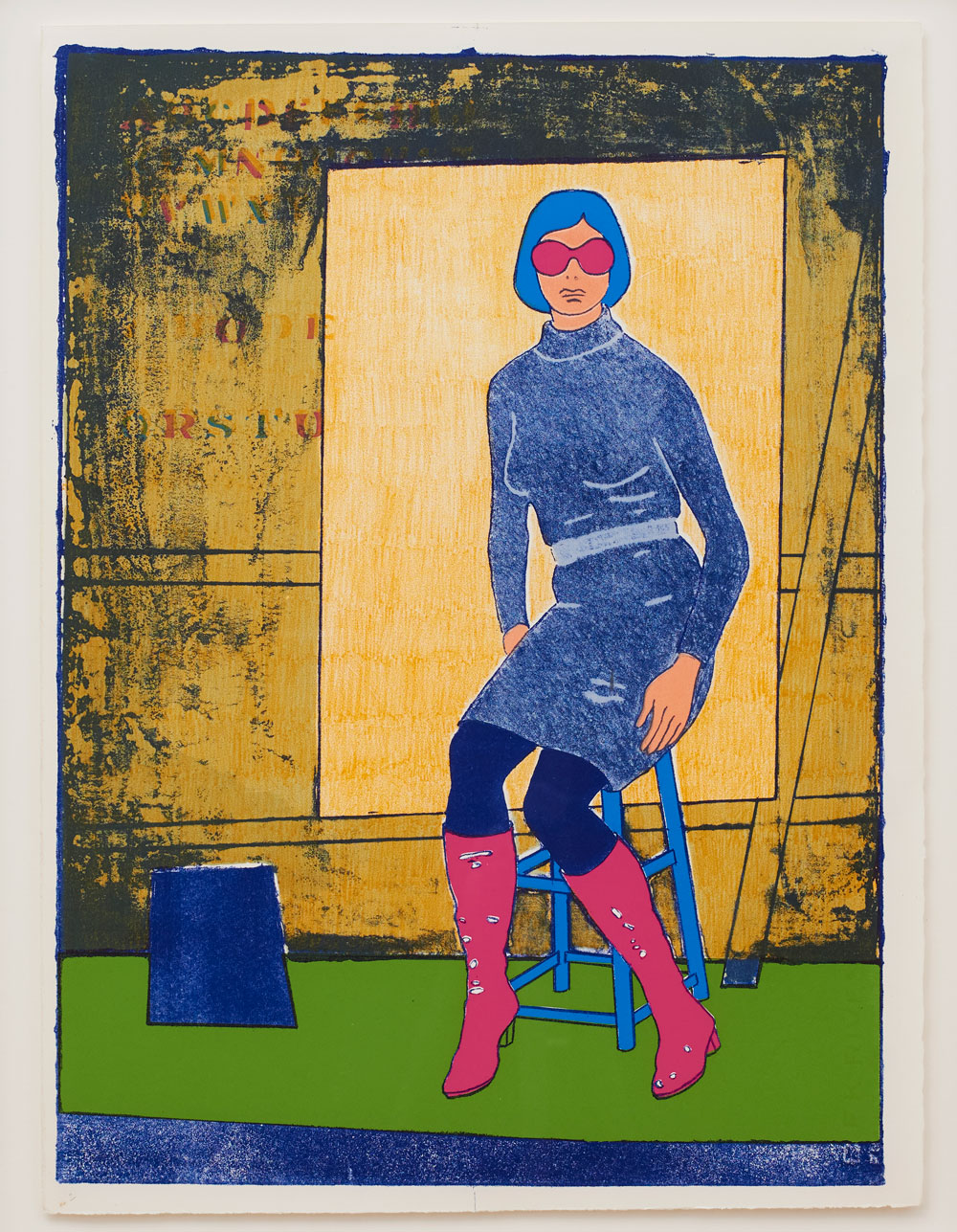
Erica Rutherford, The Startled Model, 1977. Lithograph on paper,
58 x 43 cm. Copyright of the Estate of the Artist and Courtesy Richard Saltoun Gallery, London, Rome and New York.
With not much more than a handful of small exhibitions in the 1960s, 70s and 80s, and most of those in Spain and Canada, it has taken until now for Rutherford’s work to begin to be properly recognised. She was part of the landmark exhibition Women in Revolt! at Tate Britain, and Juliet Jacques writes eloquently about her work in the catalogue of that exhibition. This year’s Venice Biennale has, for the first time, included Rutherford, showcasing five of her works. Here her flat, faceless and featureless figures of the 70s reflect on gender construction in a pop art style that the writer, cultural critic and scholar Jay Prosser has described as “envisioning the woman Rutherford wishes to become and are gradually transformed as she transitions into a record of that becoming … the painted self-portrait appears as a model for the transsexual body to follow”. In a third exhibition of her work, Erica Rutherford: Her Lives and Works, the Confederation Centre Art Gallery in Charlottetown, Prince Edward Island, is showing a major retrospective that includes more than 100 works alongside memorabilia and photographs.
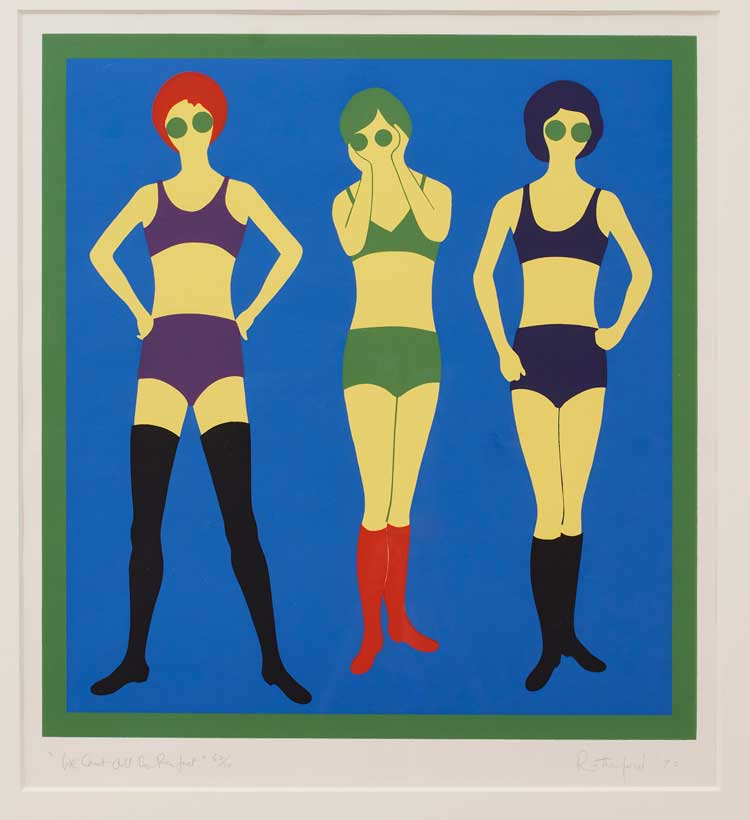
Erica Rutherford, We Can’t All Be Perfect, 1970. Screenprint on paper, 58 x 52 cm. Copyright of the Estate of the Artist and Courtesy Richard Saltoun Gallery, London, Rome and New York.
The focused exhibition at Richard Saltoun Gallery in London may be small, with just 13 works, but it serves an important purpose in the way it bookends Rutherford’s career, showing the important shifts that take place between early and late work. In works from the 70s such as The Startled Model (1977) and We Can’t All Be Perfect (1970), what Rutherford’s life-partner called her “trans-hardedge series”, Rutherford’s personal exploration of gender dysphoria is, in a sense, chronicled in these stylistic figurative works, minimalistic in form, and in their use of primary colours and hard edges. The simplicity of her monochromatic background fields and flat, featureless, faceless figures lend them a fluidity. Using the visual language of pop art, she dresses the figures in fashionable women’s clothing, gesturing to mass media portrayals of identity and gender. In this way, these are firmly personal reflections of her transition, while also offering general commentary on the societal and cultural pressures that act to shape identity. These ideas are further explored in works such as Tokyo Toughies (1971), in which two faceless figures in the same style grapple in wrestling holds. The reference to Tokyo implies this is a Japanese wrestling bout, a sport associated with male competitors, at least in the 70s when this was painted. However, the slim elegant legs of the figures belie this masculinity and instead suggest a femininity at odds with the context.
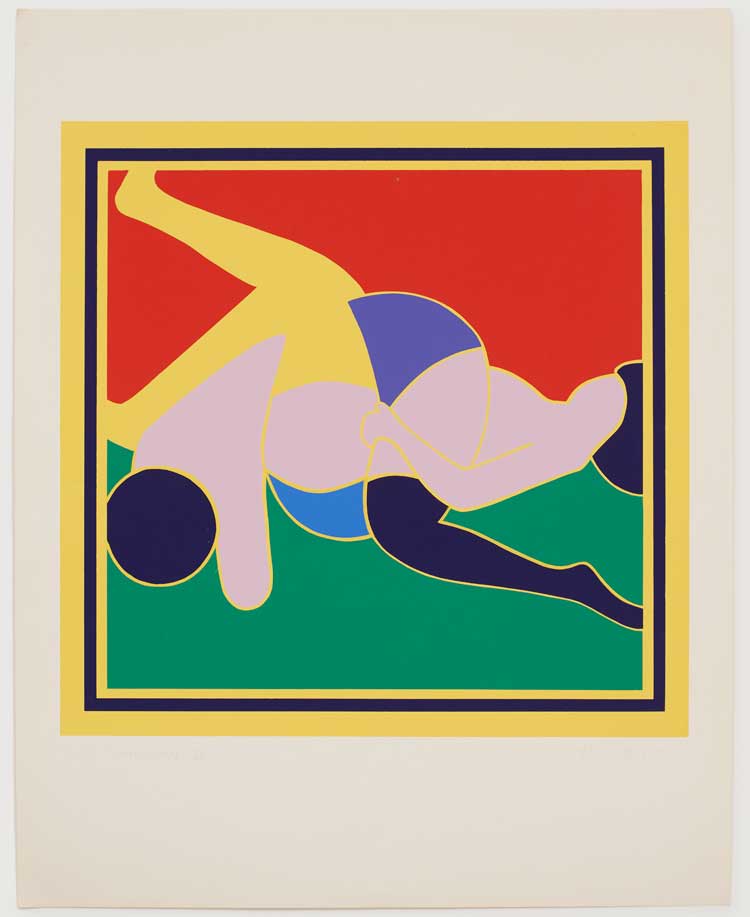
Erica Rutherford, Tokyo Toughies , 1971. Screenprint on paper, 51 x 51.5 cm. Copyright of the Estate of the Artist and Courtesy Richard Saltoun Gallery, London, Rome and New York.
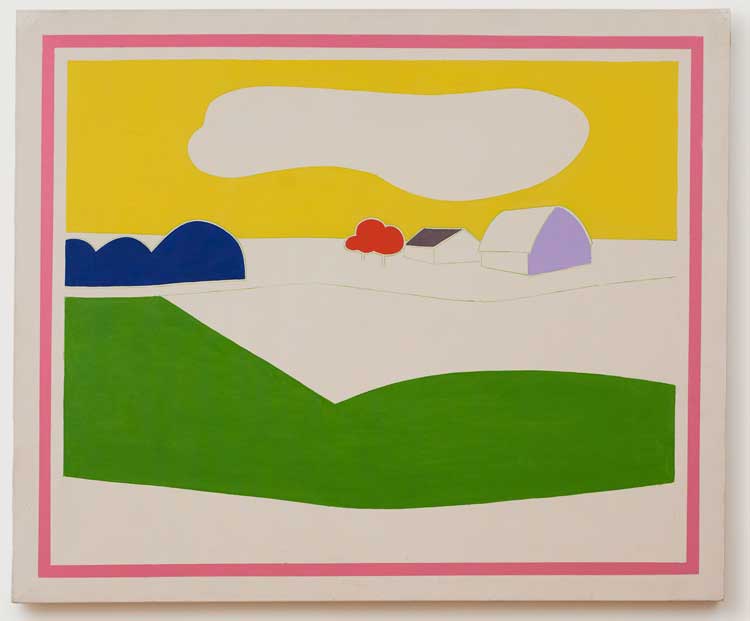
Erica Rutherford, The Green Field, 1975. Acrylic on canvas, 147 x 122 cm. Copyright of the Estate of the Artist and Courtesy Richard Saltoun Gallery, London, Rome and New York.
Graphic landscapes of the same period such as Christmas Landscape and Cherry Valley Park (both 1973), and The Green Field (1975) adopt a similar pop art style but with a sparseness that leaves as much undefined as it sets on the canvas. This openness lends these works affinity with the figurative works just discussed. In Kentucky Landscape (1970), Rutherford adopts an intense palette of luxuriant pink and purple that fill the entire image. A small idyllic homestead with trees and verdant surroundings occupies the centre of the picture, which is framed by a luminescent orange-pink landscape and a saturated purple sky above indicating an emotional and psychological dislocation.
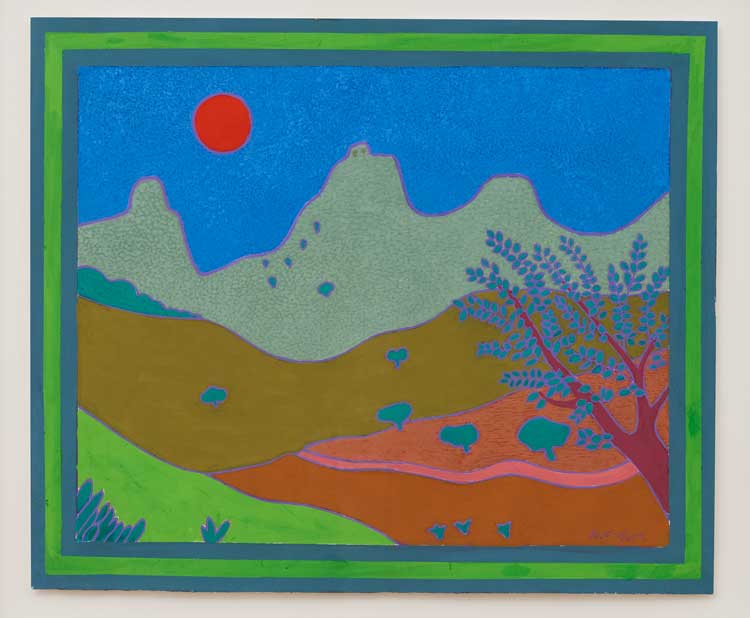
Erica Rutherford, Land of the Bong Tree, 1986. Gouache on paper, 38.2 x 46 cm. Copyright of the Estate of the Artist and Courtesy Richard Saltoun Gallery, London, Rome and New York.
Rutherford’s landscapes develop in the 80s and the exquisite Land of the Bong Tree (1986) betrays a distinctly Japanese influence. There is greater depth and texture in this work than in earlier landscapes and the delicate patterning deployed across individual areas of flat colour lend interest and might be read as a more feminine approach. Similarly, the interior scene of Talia Sees …? (1980) might be read as a feminine domestic scene complete with cat, plant and tea pot.
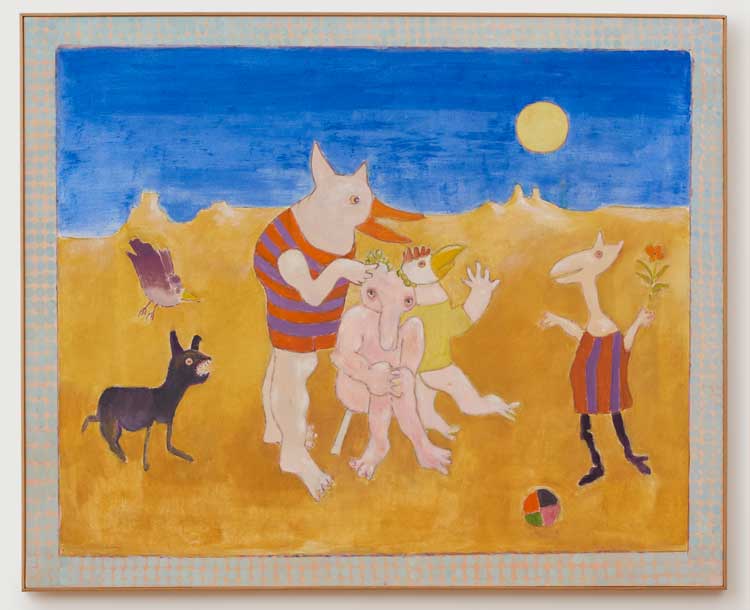
Erica Rutherford, The Maiden, 2003. Oil on canvas, framed: 113.7 x 139 cm. Copyright of the Estate of the Artist and Courtesy Richard Saltoun Gallery, London, Rome and New York.
Things change tremendously when we get to the later works in this exhibition: The Maiden (2003), The Musicians (2001-03), A Dance (1997) and To My Tune (1995). Made two decades after her transition, Rutherford’s extensive 90s series The Human Comedy, a play on Dante’s Divine Comedy (c1308-21), demonstrates a return to figuration that is almost surrealist in its approach. Bodies hover between male and female, between beauty and ugliness, between happiness and horror. Darkly humorous, these theatrical works leave a pop aesthetic behind for something more fluid in form and content where human and non-human animals enact and perform gender fluidity in natural landscapes. In acts of creative ingenuity, the figures variously dance, play music or appear to exchange ideas among themselves. The freedom and openness of these images is pronounced. Life is not, however, straightforward for the creatures in Rutherford’s The Human Comedy. For alongside the dancing figures, happy in their ambiguously fluid gender, danger and disapproval is always lurking in the form of a black animal – a cat, dog or crow, often shown in a threatening manner. Despite the freedom to think and feel and portray these fluidities in later life Rutherford, it seems, still recognised the threat and discomfort of disapproval waiting malevolently in the wings.
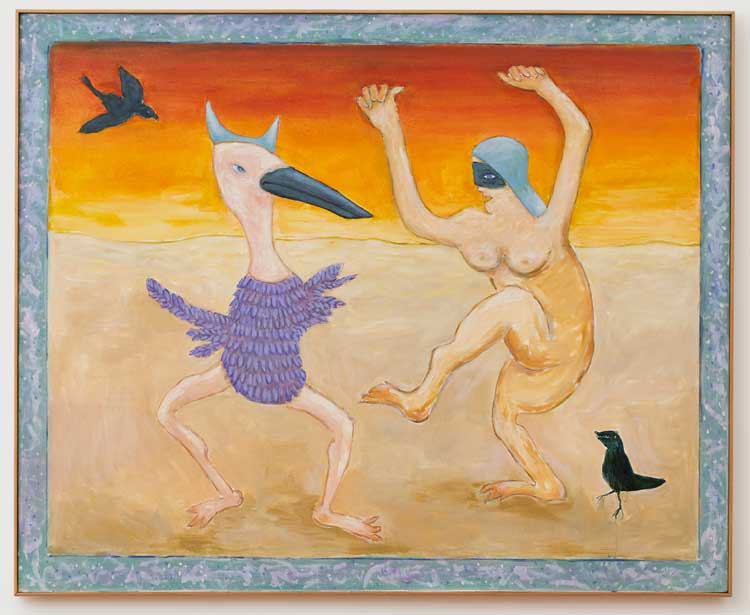
Erica Rutherford, A Dance, 1997. Oil on canvas, framed: 113.7 x 139 cm. Copyright of the Estate of the Artist and Courtesy Richard Saltoun Gallery, London, Rome and New York.